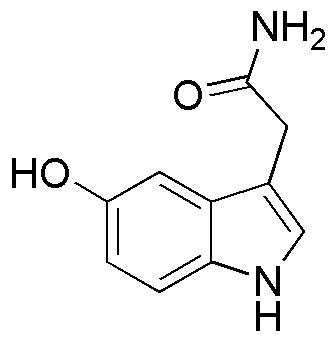5-Hydroxyindole-3-acetamide is widely utilized in research focused on:
- Pharmaceutical Development: This compound serves as a key intermediate in synthesizing various pharmaceuticals, particularly those targeting neurological disorders, enhancing drug efficacy and specificity.
- Biochemical Research: It is employed in studies investigating serotonin pathways and their implications in mood regulation, offering insights into potential treatments for depression and anxiety.
- Antioxidant Studies: The compound is explored for its antioxidant properties, which can be beneficial in formulating products aimed at reducing oxidative stress in cells, relevant in both health and cosmetic industries.
- Diagnostic Applications: It is used in developing diagnostic tools for measuring serotonin levels in biological samples, aiding in the diagnosis of various psychiatric and gastrointestinal disorders.
- Material Science: The compound finds applications in creating specialized materials, such as sensors or drug delivery systems, due to its unique chemical properties that enhance performance and reliability.
General Information
Properties
Safety and Regulations
Applications
5-Hydroxyindole-3-acetamide is widely utilized in research focused on:
- Pharmaceutical Development: This compound serves as a key intermediate in synthesizing various pharmaceuticals, particularly those targeting neurological disorders, enhancing drug efficacy and specificity.
- Biochemical Research: It is employed in studies investigating serotonin pathways and their implications in mood regulation, offering insights into potential treatments for depression and anxiety.
- Antioxidant Studies: The compound is explored for its antioxidant properties, which can be beneficial in formulating products aimed at reducing oxidative stress in cells, relevant in both health and cosmetic industries.
- Diagnostic Applications: It is used in developing diagnostic tools for measuring serotonin levels in biological samples, aiding in the diagnosis of various psychiatric and gastrointestinal disorders.
- Material Science: The compound finds applications in creating specialized materials, such as sensors or drug delivery systems, due to its unique chemical properties that enhance performance and reliability.
Documents
Safety Data Sheets (SDS)
The SDS provides comprehensive safety information on handling, storage, and disposal of the product.
Product Specification (PS)
The PS provides a comprehensive breakdown of the product’s properties, including chemical composition, physical state, purity, and storage requirements. It also details acceptable quality ranges and the product's intended applications.
Certificates of Analysis (COA)
Search for Certificates of Analysis (COA) by entering the products Lot Number. Lot and Batch Numbers can be found on a product’s label following the words ‘Lot’ or ‘Batch’.
*Catalog Number
*Lot Number
Certificates Of Origin (COO)
This COO confirms the country where the product was manufactured, and also details the materials and components used in it and whether it is derived from natural, synthetic, or other specific sources. This certificate may be required for customs, trade, and regulatory compliance.
*Catalog Number
*Lot Number
Safety Data Sheets (SDS)
The SDS provides comprehensive safety information on handling, storage, and disposal of the product.
DownloadProduct Specification (PS)
The PS provides a comprehensive breakdown of the product’s properties, including chemical composition, physical state, purity, and storage requirements. It also details acceptable quality ranges and the product's intended applications.
DownloadCertificates of Analysis (COA)
Search for Certificates of Analysis (COA) by entering the products Lot Number. Lot and Batch Numbers can be found on a product’s label following the words ‘Lot’ or ‘Batch’.
*Catalog Number
*Lot Number
Certificates Of Origin (COO)
This COO confirms the country where the product was manufactured, and also details the materials and components used in it and whether it is derived from natural, synthetic, or other specific sources. This certificate may be required for customs, trade, and regulatory compliance.


